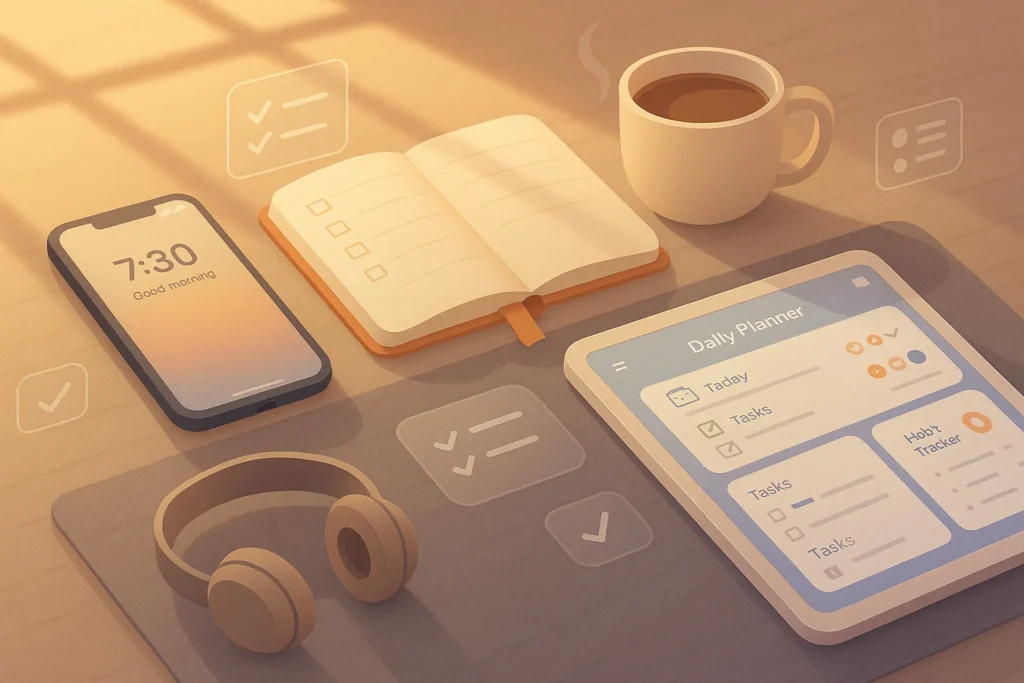-This post may contain affiliate links. If you click on one and make a purchase, I may earn a small commission at no extra cost to you.-
🧭 Introduction: Why Most Routines Fail—And How Yours Won’t
Let’s be honest—how many times have you tried to start a new routine, only to drop it within days?
Maybe it was waking up earlier, reading before bed, or doing a short workout in the morning. The first few days? Solid. By day six? Gone.
The problem isn’t you—it’s the system.
In this guide, you’ll learn how to build a daily routine that actually sticks. One that feels sustainable, doesn’t rely on willpower, and grows with your life. Backed by behavior design principles and supported by habit-tracking tools like Habitica, Streaks, Fabulous, and Sunsama, you’ll walk away with a 5‑step method to make new habits feel natural—not forced.
Let’s turn your intentions into something you actually look forward to.
1️⃣ Step 1: Define Your “Why” & Anchor Point
Your brain craves meaning—without it, even the best habits feel like chores. Before setting alarms or downloading trackers, get crystal clear on why you’re doing this.
Ask yourself:
-
What will this habit unlock for me?
-
How will my day feel different?
-
Who else benefits when I succeed?
Once your why is defined, pair your new habit with an existing anchor. This is called habit stacking, a method introduced by James Clear. Anchors make routines frictionless because you’re not starting from zero—you’re building on what already happens.
Example:
-
After brushing my teeth (existing habit), I’ll do 10 squats (new habit).
-
After pouring my morning coffee, I’ll open Sunsama and set my top 3 tasks.
This micro-contextualization is what makes your habit “stick.”
Building any habit starts with a clear motivator—your personal why. Want more energy? Quality time with family? Stress reduction?
Once you’ve identified your why, link the new habit to an existing behavior. For example:
-
“After I brew coffee in the morning (existing habit), I will journal for 5 minutes (new habit).”
-
“Before I check email at night, I will stretch for 3 minutes.”
Helpful app:
Use Habitica to set habit points and reminders for your anchor. It gamifies your behavior, making you accountable.
2️⃣ Step 2: Use Tiny Habits & Set It Up For Success
Most people try to overhaul everything at once—then burn out. The better way? Start embarrassingly small.
Your only job in week 1 is to show up, not succeed.
Instead of:
“I’ll write 1,000 words a day” → try “I’ll open my writing app and write one sentence.”
Why this works:
-
Builds psychological momentum
-
Keeps failure rate at zero
-
Increases confidence through identity shifts: “I am someone who shows up.”
Apps like Streaks reward even the smallest actions. You don’t need a big win—just a perfect chain of small ones.
Consistency beats intensity every single time.
One of BJ Fogg’s core strategies is starting small. Want to read more? Begin by reading one page. Want to exercise? Start with one push-up.
-
Tiny doable actions lower resistance and build consistency.
-
Once tiny feels automatic, incrementally increase.
App recommendation:
Streaks helps track tiny habits—like drip water, one page, or posture reminders—so you celebrate “every single day” wins.
3️⃣ Step 3: Track Progress + Celebrate Wins
Tracking turns invisible effort into visible progress. And in habit formation, what gets measured gets reinforced.
Your tools:
-
Pen and paper habit tracker
-
Mobile apps like Fabulous or Habitica
-
Notion-based trackers with emojis, streaks, and self-rating
Build in simple, emotional rewards:
-
Check a box, smile.
-
Say “I did it” aloud.
-
Sip your favorite drink after completing your routine.
Neuroscience backs this: dopamine surges when we recognize completion and associate it with something pleasurable.
Tracking builds awareness and reward. Even a simple check mark triggers dopamine—giving your brain a natural high.
-
Use a habit tracker every night: tick off morning routine, hydration, reading, planning.
-
Pair a small reward—like 5 minutes of scroll time or your favorite tea.
App suggestion:
Fabulous uses behavioral coaching, daily journaling prompts, and rewards to help you build a chain of successful habits.
4️⃣ Step 4: Plan Your Day in Advance
Routines fall apart when you “wait to feel ready.”
Instead, pre-commit to your routine the night before. Write it down. Visualize it.
Evening Planning Ritual:
-
Review today → What did you skip? What went well?
-
Plan tomorrow → Slot in your key habit windows
-
Visualize → “I’ll wake up, stretch, journal, and eat—all by 9AM”
This level of intentionality makes routines flow instead of being forced.
Use Sunsama to assign tasks to time blocks, integrate your calendar, and reflect at day’s end. It’s more than a planner—it’s a behavior coach.
A strong routine supports execution—not replaces it. Each evening, carve out 10 minutes to plan the next day.
-
Identify top 3 priorities (MITs)
-
Include routine anchors and non-negotiables
-
Visualize transitions (e.g., workout → shower → breakfast)
Tool to use:
Sunsama combines task planning, calendar, reflection prompts, and integrates with Notion or Google Calendar—helping you commit to your plan.
If you’re serious about aligning your routine with deeper work systems, don’t miss our guide on building a productivity system that actually works—it’s the next level after mastering your daily flow.
5️⃣ Step 5: Design for Obstacles & Reflection
Every habit hits friction: travel, mood, stress, lack of sleep.
Winning systems don’t avoid failure—they expect it and adapt.
Create a Weekly Habit Reflection Ritual:
-
“Which habits felt smooth? Which ones slipped?”
-
“Did my why still feel relevant?”
-
“Should I change the time or environment?”
Use this time to adjust—not abandon.
Apps like Fabulous include end-of-week check-ins. Or build a Notion dashboard with toggles:
✅ Habit felt easy
❌ Felt forced
🛠️ Adjust needed
This creates a feedback loop where habits evolve as you do.
Even the best plans run into resistance. Reflect and adjust:
-
Identify triggers behind failures (e.g., too tired, too busy)
-
Adjust context or schedule accordingly
-
Run weekly check-ins: “What worked? What didn’t?”
Free tool tip:
Use a simple Notion or Notion AI template (see our “Productivity System” guide) for weekly reflection and habit adaptation.
🔁 Bonus: What To Do When You Miss a Day (Without Losing Momentum)
Here’s a truth that rarely gets mentioned: You will miss a day. Life will interrupt. Motivation will fade. That’s okay.
What matters most is how you respond when you fall off.
🧩 Shift From Perfection to Resilience
Instead of aiming for perfection, build the identity of someone who always returns. Missing one day is human. Missing two starts a new bad habit.
📌 Rule: “Never miss twice.”
If you skip Tuesday? Commit to a small version on Wednesday. Even 1 push-up or 30 seconds of journaling maintains your identity.
🧰 Create a “Low-Energy” Backup Version of Your Routine
Plan for low-motivation days ahead of time. This lowers the mental barrier to returning.
Example:
-
Instead of a full workout → 3-minute walk
-
Instead of 20-minute journaling → write one sentence
-
Instead of meditation → 3 deep breaths
Store these backups in your Sunsama or Notion dashboard as “Fallback Routines.”
🔄 Use “Reset Rituals” on Sundays or Mondays
Pick one day per week to realign with your habit system:
-
Revisit your why
-
Review your anchor habits
-
Update your task tracker or app dashboard
-
Schedule your top 3 non-negotiables for the week
Think of it as “reinstalling your routine OS.”
By designing for disruption, you make your routine antifragile—it gets stronger through failure.
The goal isn’t streaks. The goal is return.
📱 App Comparison Table
| App | Purpose | Starting Cost | Standout Feature |
|---|---|---|---|
| Habitica | Habit gamification | Free | Point system, social accountability |
| Streaks | Simple daily tracker | $4.99 (iOS) | Intuitive UI, streak visuals |
| Fabulous | Guided behavior coaching | Free trial | Daily journeys + coaching loops |
| Sunsama | Daily day planner | $20/month | Calendar + tasks + mind mapping |
Each of these tools excels in reinforcing one of the 5 routine pillars. Choose the one that matches where you’re most vulnerable.
🧠 Nerd Verdict
A lasting daily routine isn’t built on willpower—it’s built on designing consistent structure, tracking behavior, and iterating. When you combine:
-
a clear why
-
tiny start
-
progress feedback
-
daily planning
-
reflection cycles
…you’re setting up a system that grows with you—not breaks you.
Apps are accelerators here—they help automate tracking, build awareness, and support accountability. Habitica, Streaks, Fabulous, and Sunsama each bring unique strengths to different parts of the routine puzzle.
❓ FAQ
Q: How long does it take for a habit to stick?
A: While the 21-day myth is old, most habits take 45–60 days of consistent repetition. Success depends on simplicity and tracking.
Q: Should I use one app or multiple apps?
A: Start with one tool that matches your biggest need (e.g., tracking or planning). You can layer a second tool later if required.
Q: What if life gets in the way?
A: Reset with a smaller version of your routine. Missed Tuesday? Do half your mini-habit anyway—the point is consistency, not perfection.
Q: Can routines change over time?
A: Absolutely—use weekly reflection to guide tweaks, not gut feelings. Let your environment and energy shape adjustments.
💬 Would You Bite?
Which of these 5 steps feels most challenging for you right now? Which app are you excited to try first—and why?
Comment below—every reader’s journey matters, and I reply personally!👇



